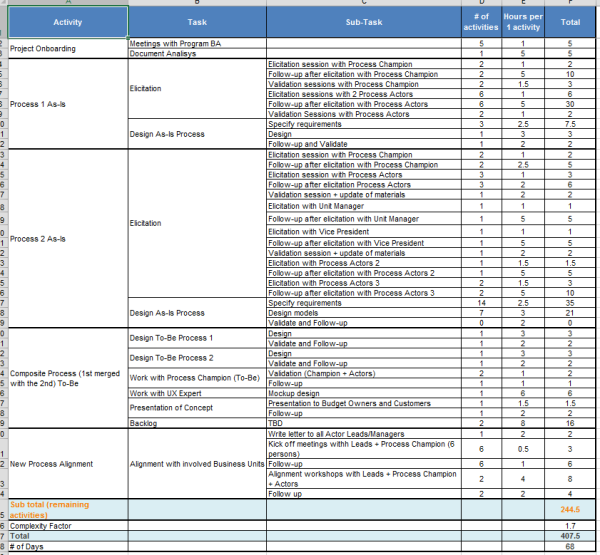What is the next step? When will you finish this activity? What are the deliverables? Did your manager or your customer ask you these questions? Planning is the process of thinking about and organizing the activities required to achieve a desired goal. Building and following a plan is similar to using of a map that provides you with the route to follow. You always know where you are and what is the next step. I would turn to Business Analysis Plan in case such questions arrive.
Plan your journey – start new project properly with the Plan Business Analysis Activities task. It’s purpose is to:
Determine the activities that must be performed and the deliverables that must be produced, estimate the effort required to perform that work.
– Direct quote from Business Analysis Body of Knowledge®
I would start with the end in mind: key deliverable here is the BA Plan itself. Let’s see what it is. In case you do it for the first time its useful to have any template (Organizational Process Assets). I’ve passed several iterations before the “normal quality” artifact was produced and approved.
So… Activities and deliverables. They are just work breakdown structure (WBS) of an activity assigned to BA. As always, it’s easier said than done. What does WBS for analyst’s work consist of? Several factors are vital here.
First of all, I would think about the project and its stage. Initiating of the project? Then you should read precisely what Enterprise Analysis knowledge area consists of. Follow tasks one by one and you’ll help the project to be approved. Initiated and ongoing project? Nice, take the development process description (pay attention to approach – Plan-driven or change-driven) and align corresponding BA task from BABOK to team activities.
Another hot point – the solution scope. This may help you significantly to identify vectors of work to be covered by you. In case solution contains several processes you should plan set of tasks per process. By the way works per process may be the same. Solution consists of organizational change and development effort as well? Okay, then work with Subject Matter Expert to produce BA tasks to be executed in scope of change. Then include identified exercise as well as development related workload into activity list.
Following idea also may be helpful. Build list of activities based on identified stakeholders (Stakeholders List, Roles & Responsibilities). Take a look at RACI matrix. Amount of elicitation meetings depends on how many “Consulted” guys are on the list. Those who are marked as “Approver/ Accountable” are also counted as effort to communicate and so on.
You may use templates. What I mean here is a standard consequence of activities that always go together. Example: You always have to prepare for elicitation, then you elicit requirements, document and confirm. Put here one more task dedicated to update of materials after feedback from validation meeting. Do not forget to communicate the latest version of deliverable. Next time you plan any elicitation you may apply this chain of efforts spending less time for planning and estimation. Call for your imagination to build your own templates and remember to read BABOK carefully.
You have to predict the quantity of iterations for each activity. Imagine you practice lean prototyping and co-design sessions with your stakeholders. Taking into account the volume of the feature under analysis you may plan, let it be, 4 research sessions and 2 validation sessions. Use these multipliers to calculate total estimate for the feature.
Now that you are able to define the set of activities to be performed during analysis it’s time for estimates. Key inputs here are expert judgement and your experience. Apply your knowledge from previous projects, from the similar cases you’ve completed before. Some senior guy always exists in your company – consult him. Once again it makes sense from the techniques perspective to mention BABOK. Estimation is one that is used here.
Let’s look what we’ve got in the end. We completed list of activities. Also multiplicity per each activity is identified. Estimation is in place. Multiply quantity per estimate for each activity in the list. Then build a total sum and you are done! One thing left to mention – consider assumptions.
IIBA provides us with the Quick Tip on this topic. QT 49 is called “Estimating the Requirements Effort” (IIBA members only). In general it’s nice example of what we are going to produce while performing Plan Business Analysis Activities task. The most valuable, from my point of view, section within this article is about assumptions. As estimation is just a guess try to build it based on complexity hypothesis to make it more reliable. You may find example on assumptions within my template as well.
It’d like to close this topic by mentioning Manage Business Analysis Performance task. BA Performance Assessment shall be considered while maintaining your plan. You may update your activities list as new details appear and you understand what to do next (rolling wave planning).
Final thing. Plans are not for the blind following. Plans are for vision of a desired goal. Adjust and update them to be more effective and efficient. Don’t be afraid – changes are just normal.
P.S. Those who would like to use suggested template click link: BA Plan_Efforts Estimation_Template.
P.P.S. Still thinking about BA career? Read my previous post To BA or Not to BA for insight.

